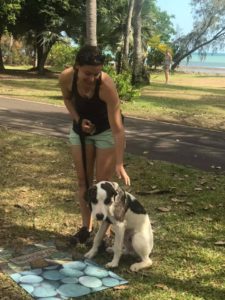The interesting thing about dog training is that no matter what we know or what we think we know we can always learn something new. For someone lie me who has been working with dogs a long time it is never more true, every day I can learn something new.
Dogs are challenging and awesome and hard work and the best comforters available but they also leave us with out a clue sometimes.
Reactive dogs are the most difficult because we often mis-understand their intent and because of this we end up with a dog who is more reactive rather than less after we comfort them. An important step in the training is to understand what the dog is reactive about and o see if there are any proceeding triggers, ie is he better if you walk to the park or drive to the park, does he lie it better when he sees a friend or when he is left alone. Understanding our dogs reactivity is key to helping reduce it.
 For many of us communication is a key issue that we just haven’t learnt yet, and doing some simple activities can sometimes over come major issues.
For many of us communication is a key issue that we just haven’t learnt yet, and doing some simple activities can sometimes over come major issues.
Socialisation is a key ingredient for puppies and we so often miss the cut off times for puppies development. This can lead to major behaviour problems later in life. Too often we think that socialisation is about our dogs getting along with each other, but it is so more than just other dogs, it is about new experiences. It is about car rides, swimming, kids and beards and hats. Socialisation is about building resilience so no matter what comes your dogs way the your dog can cope with the adventure that is before them.
Reactive behaviour stems from fear often, then we try to add reassurance, touch soft voice getting close to our dog and this confuses our dog, tells him that we too are feeling his stress. Next time we head into a similar situation we find ourselves tightening the lead just in case, the dog takes this as an indication trouble is ahead, he doesn’t know he is the trouble and he reacts with a bark or lunge and the process begins to build.
If instead our dog is excite and happy for new situations we can still find our selves hauling on the end of the lead, signalling to the dog there is a problem ahead. Honestly i get this, Sparkie is always lunging at end of lead to meet every other dog he sees, and sometimes he is barking at the same time you can see people backing slowly away. He isn’t aggressive and he loves other dogs but it is off putting.
I can resolve this by gaining focus, if he is focused on me and what I am doing he is less likely to be at end of lead worrying about what ever else is in sight. I can manage my lead and practice having a loose lead, for some handlers this feels impossible, so the use of a second lead can help. We are jangling the lead like a tea bag rattling until our dog looks in our direction then giving huge rewards for the focus. We do not want to be ripping at their necks and heads, and if we practice this enough in calm spaces with less distractions then we will be able to manage it when the distractions become harder. If we have an ID tag on our dogs collar it can be very useful to jangle it on the end of the lead so a jangling noise is made that may help he dog be aware of you trying to get his attention.
Try hard not to speak, too much talking can be confusing for the dog and make training harder. Use talking for rewards and fun stuff. Limit use of their name for good stuff, if I call Sparkie I want him to be looking for the reward.
Want to know more
Join us at https://www.facebook.com/TrainatPAWSDarwin for locations of classes
